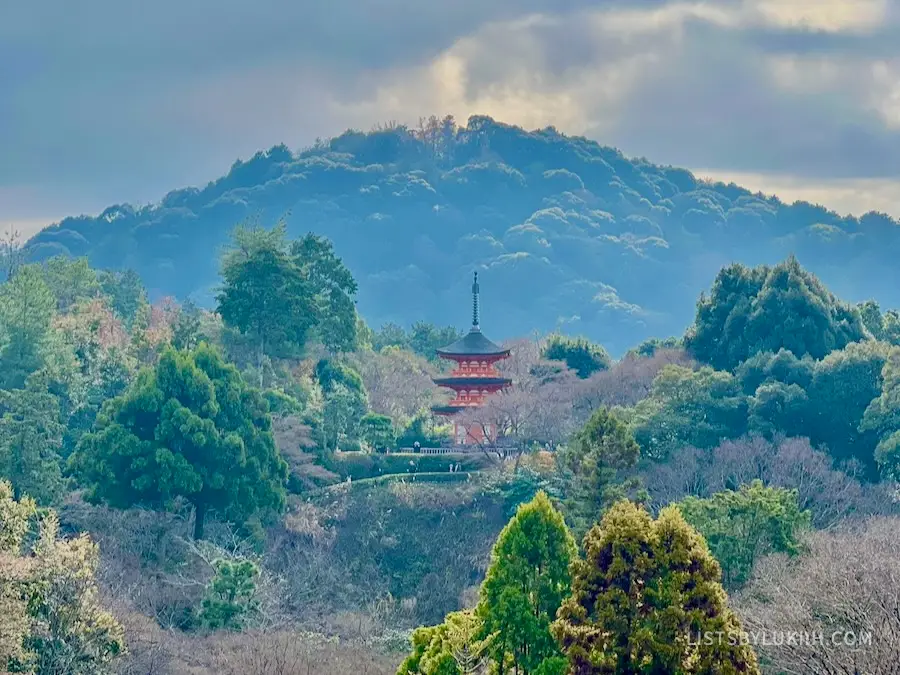Receiving over 36 million tourists in 2024, Japan is one of Asia’s most popular destinations and is known for natural hot springs, cherry blossoms, and historic temples. Having spent over two weeks in Japan, I share well-researched and firsthand travel tips that are especially useful for first-time visitors.
Lists By Lukiih is readers-supported. When you buy with my affiliate link, I may earn a small commission. Thanks!
📌 Planning
Popular Places l When To Visit l How Long To Visit l Entry Requirements
Popular Places
- Tokyo – a bustling metropolis known for its culinary scene, world-class shopping, and modern architecture. Some of its biggest attractions include Tokyo Skytree and Senso-ji.
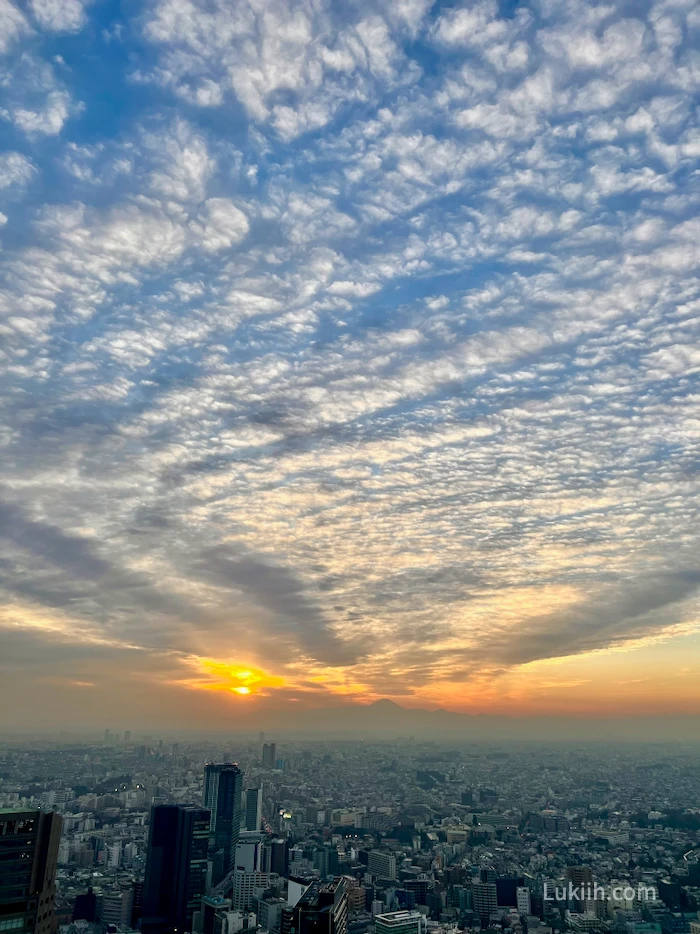
- Kyoto – known as “The City of Ten Thousand Shrines”, Kyoto is known for its well-preserved historical sites that mix temples and shrines with modern architecture. Some of its biggest attractions include Kinkaku-ji, Fushimi Inari Taisha, and Arashiyama Bamboo Grove.
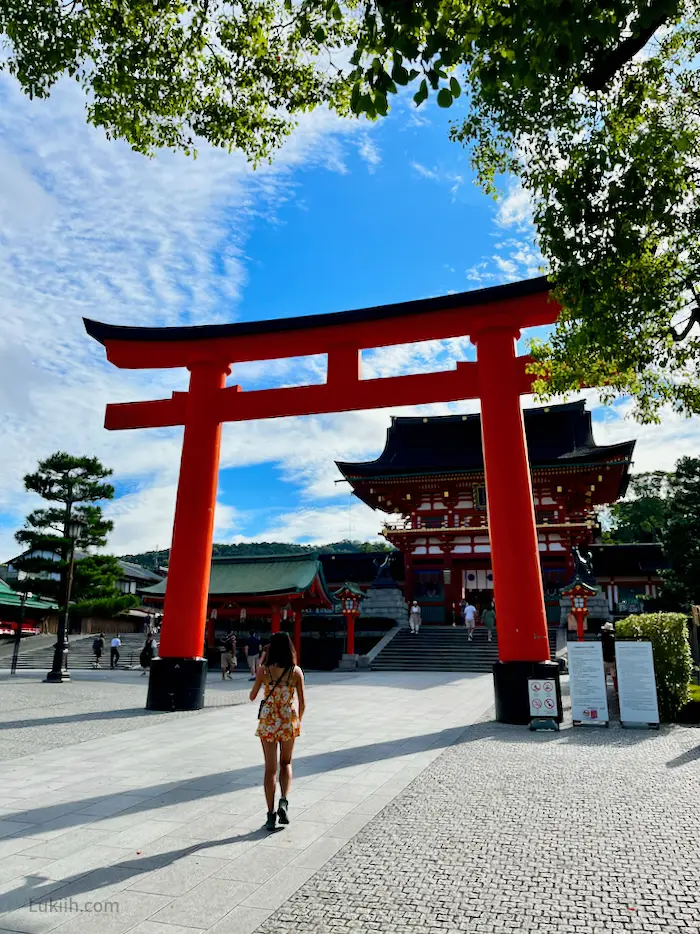
- Osaka – called the “Kitchen of Japan”, Osaka is renowned for its street food and nightlife scene. The Dotonbori area is especially popular.

- Hakone – a town surrounded by beautiful nature and especially known for its onsens, (natural hot springs).
- Nara – famous for its free-roaming deer in Nara Park. This has made Nara viral on social media, as visitors find the bowing deer adorable.
- Mt. Fuji – one of Japan’s most iconic symbols. The Mt. Fuji volcano has the country’s highest peak. There are many beautiful photos of Mt. Fuji, but you can also hike it.
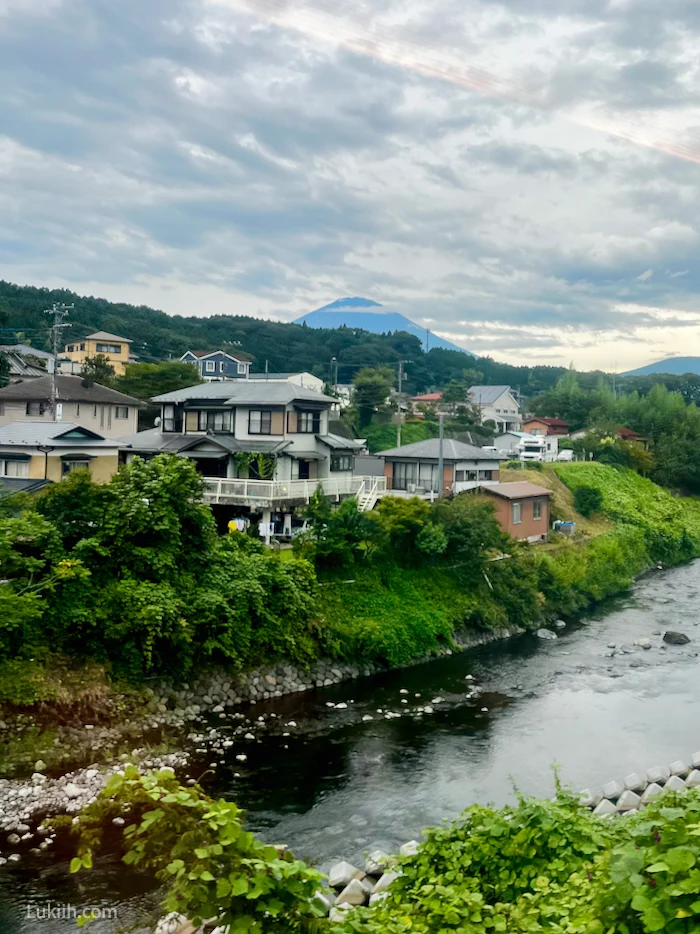
I visited all the places above except for Nara, and here are my honest thoughts on them:
- Tokyo – Tokyo is worth visiting as it’s an amazing city with a mind-blowing culinary scene. It has an abundance of amazing restaurant options, but it can sometimes feel like another major, commercial city.
- Kyoto – Like many others, I enjoyed Kyoto the most because of its distinct and unique traditional atmosphere. It’s one of the places where you feel like you’re in Japan and nowhere else in the world.
- Osaka – I highly recommend Osaka to foodies. I thought its aquarium was uniquely well-designed, but I didn’t find the city as compelling as Kyoto or Tokyo.
- Hakone – This is a super aesthetic town where you’ll find high-quality onsens for more affordable prices compared to cities like Kyoto.
- Mt. Fuji – Hiking Mt. Fuji was one of the highlights of my trip, but it requires some physical preparation.
My Japan trip planner has firsthand tips for each destination.
When To Visit
- Spring season (March-May) – popular time to visit because it coincides with the cherry blossom season. Japan has mild, pleasant weather at this time, but it’s also extremely crowded.
- Fall season (September-November) – another popular time to visit as trees become vibrant with red and orange leaves. The landscape is simply stunning.
I visited Japan in September and found it incredibly hot, but not as crowded as my friends who visited during the cherry blossoms. The cities sometimes felt stifling, but it was cool and cloudy between sunny days. I wore shorts and tank tops most days. (Note that Japanese locals tend to dress conservatively.)
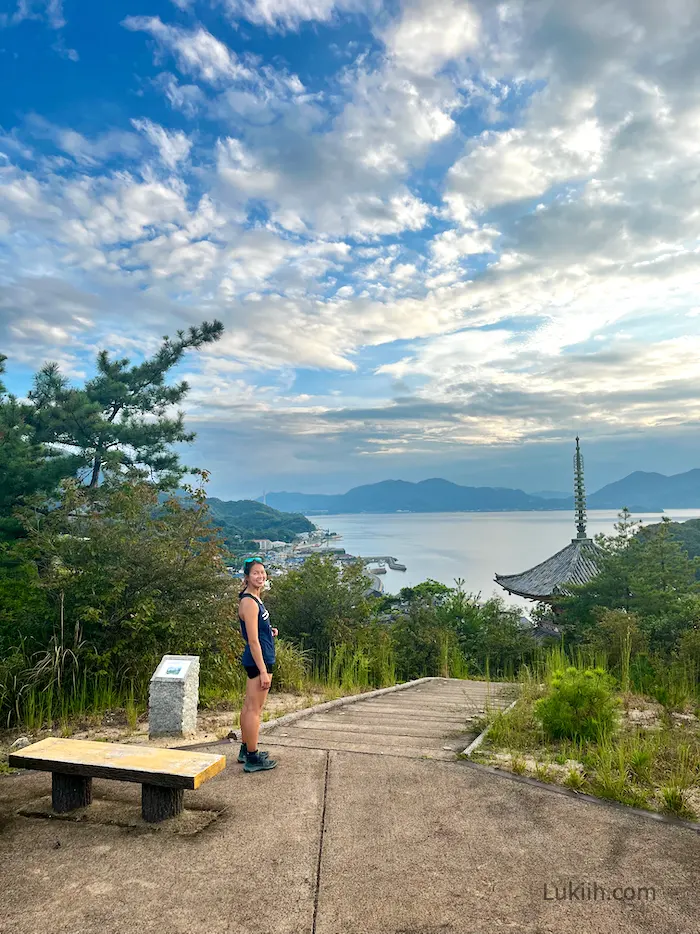
How Long To Visit
- 3-5 days – enough time to visit 1 destination (e.g., usually Tokyo, Kyoto, or Osaka)
- 1 week – enough time to visit 1-2 destinations (e.g., usually two big cities and a day trip)
- 2 weeks – enough time to visit 3-4 of the top destinations
I spent 2 weeks in Japan: 6 days in Tokyo, 2 days in Kyoto, 1 day in Osaka, 2 days climbing Mt. Fuji, and 2 days cycling the Shimanami Kaido. I could have easily spent more time in Japan. With more time, I would have stayed in Kyoto longer, visited more rural areas, and maybe gone north towards Sapporo or Hokkaido.
⛩️ 10 Epic Days in Japan: A Unique & Active Itinerary
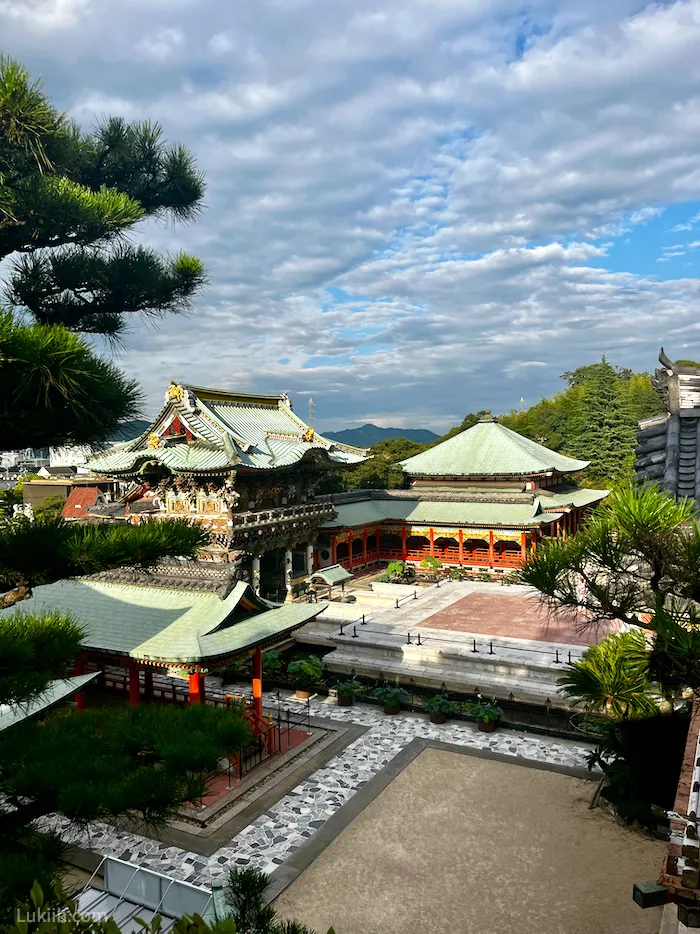
Entry Requirements
- not required for US citizens visiting Japan for up to 90 days.
- there are no entry fees, but there’s a 1,000 yen exit fee that’s typically included in your airfare.
Entering Japan was straightforward for me as a US citizen. I didn’t have to apply for a visa or pay an entry fee. My exit fee was included in my airline ticket.
💰 Logistics
Money
- Many tourist places accept credit cards, but you’ll still run into many places that require cash in Japan. You’ll even want to carry coins sometimes for luggage storage.
- The Japanese yen is the country’s official currency. USD is not widely accepted, so make sure to exchange currencies.
💰 My Japan Trip Cost: Budget Breakdown (2025)
Getting Around
- Japan has several international airports. The biggest and most commonly used ones are:
- Narita International Airport (NRT) in Tokyo
- Haneda Airport (HND) in Tokyo
- Kansai International Airport (KIX) in Osaka
- Japan is known for its vast and efficient public transit.
- For long distances, the best way to get around is by train. They’re known for their cleanliness, safety, and punctuality.
- For short distances, you can rely on Uber or Japan’s bus and metro systems.
A bullet train (shinkansen) can travel up to 200 mph, transporting you long distances in a few hours. If bullet trains existed in the United States, you could get from Boston to New York City in bit over an hour.
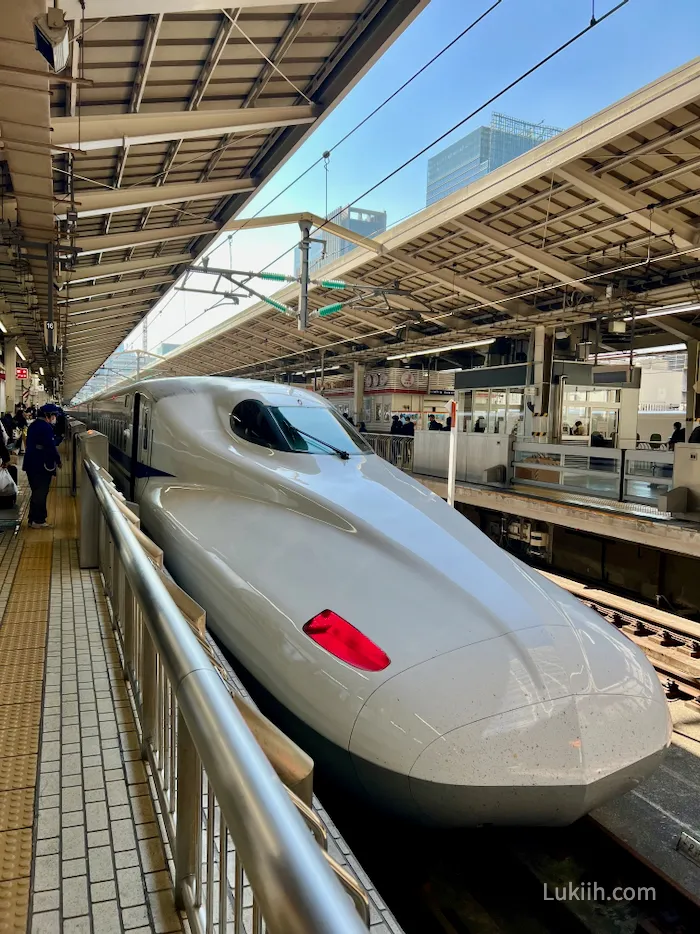
I traveled around Japan in various ways and here are my observations:
- Train – Like many visitors, I primarily relied on Japan’s trains to get around. The trains are extremely pleasant and I cannot recommend them enough. I bought a JR Pass and wished I had also gotten a PASMO card to make it more convenient to get around.
- Uber – Uber can be convenient in places where the metro doesn’t reach, but it’s not as cost-efficient as trains. When you use Uber in Japan, you’ll essentially be hailing a taxi, as it’s illegal for privately owned vehicles to rideshare.
💊 Safety
Health
- generally safe to drink. Hotels, restaurants, and tour operators often provide bottled water, but if you ask for tap water, they’ll give it to you.
- Prevalent in the summer (June–September), especially in rural and coastal areas, so protect yourself as best as you can.
I didn’t have any health-related issues in Japan.
- Tap water – I drank tap water in Japan. Water fountains are not common, but you might see a few in certain parks.
Japan is the land of vending machines. You’ll see one in every corner, even in remote areas, and it usually costs less than $1 to buy bottled water, which is about the same price you’ll find in convenience stores.
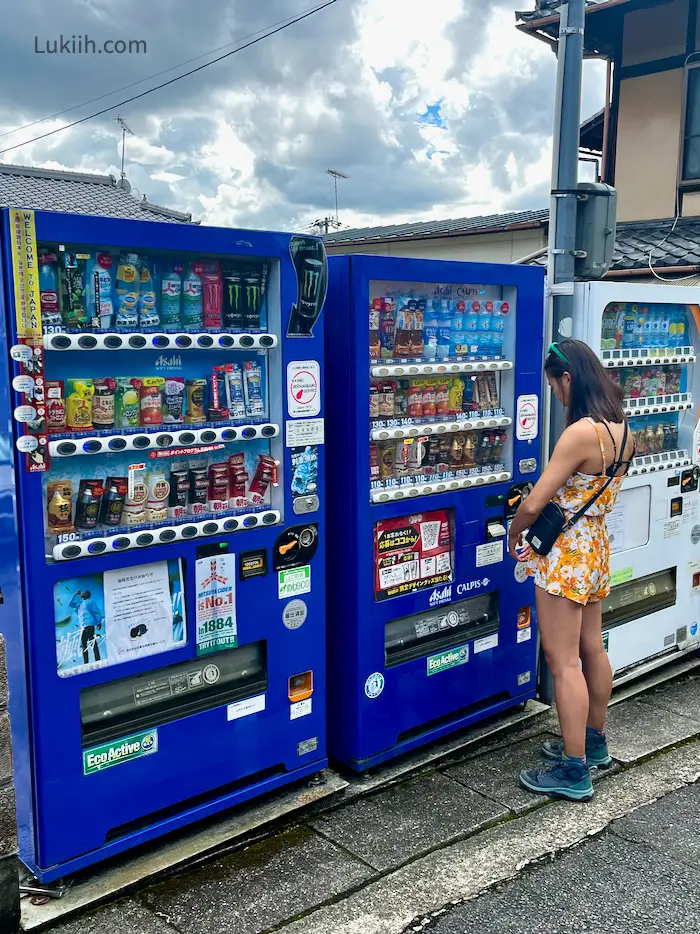
- Mosquitoes – For some odd reason, I didn’t realize Japan had mosquitoes so I didn’t pack insect repellent. I was bitten in Tokyo, Kyoto, and Gotemba, usually in areas near parks and gardens. By the end of my trip, I counted twelve mosquito bites.
Crime
- Japan is considered an extremely safe country to visit. Violence and even petty theft against tourists are rare.
- The country has a travel advisory level of 1 per the US government.
- It’s ranked #17 out of 163 safest countries by the Global Peace Index (for reference, the US is ranked #132).
- Some typical scams to watch out for include:
- The bar scam – check your bill for outrageous hidden fees at bars, especially if you were heavily encouraged to enter one.
- The fake monk scam – know that real monks don’t ask for money on the streets so refuse and walk away
- Rental scams – this includes bike and kimono rentals, so make sure to book with reputable sources
I didn’t have any issues with safety or crime in Japan. Visiting Japan as a solo female traveler is generally safe, but know that the local culture is considerably more traditional in terms of gender norms compared to the US. While catcalling is rare in Japan, watch out for groping in crowded trains, spiked drinks, and men trying to take upskirt photos.
🌍 Culture
Language l Food l What To Wear
Language
- Japanese
- not widely spoken (only about 10% of locals speak basic English in tourist areas)
Formality and politeness are important parts of Japanese culture. Many tourists will say “arigatō” to locals, which is not the proper way to say thank you. “Arigatō” is informal and should only be said to people you know well.
Japan is somewhat English-friendly because it’s such a tourist-heavy destination. Many important signs and some menus in tourist areas will be in English. Just don’t expect locals to speak fluent English and be patient when the translation isn’t perfect.
Food
- curry rice (a thick, mildly spiced curry served over rice and often paired with meat and vegetables)
- sushi (vinegared rice combined with fresh seafood, vegetables, or egg), ramen (a hearty noodle soup with rich broth, often topped with sliced pork, egg, and green onions, varying in styles by region), and okonomiyaki (a savory Japanese pancake made with batter, cabbage, and various toppings, often drizzled with sweet-savory sauce and mayo).
Japan is a haven for people who enjoy food. I cannot rave enough about the quality, uniqueness, and presentation of food everywhere I went to in Japan.
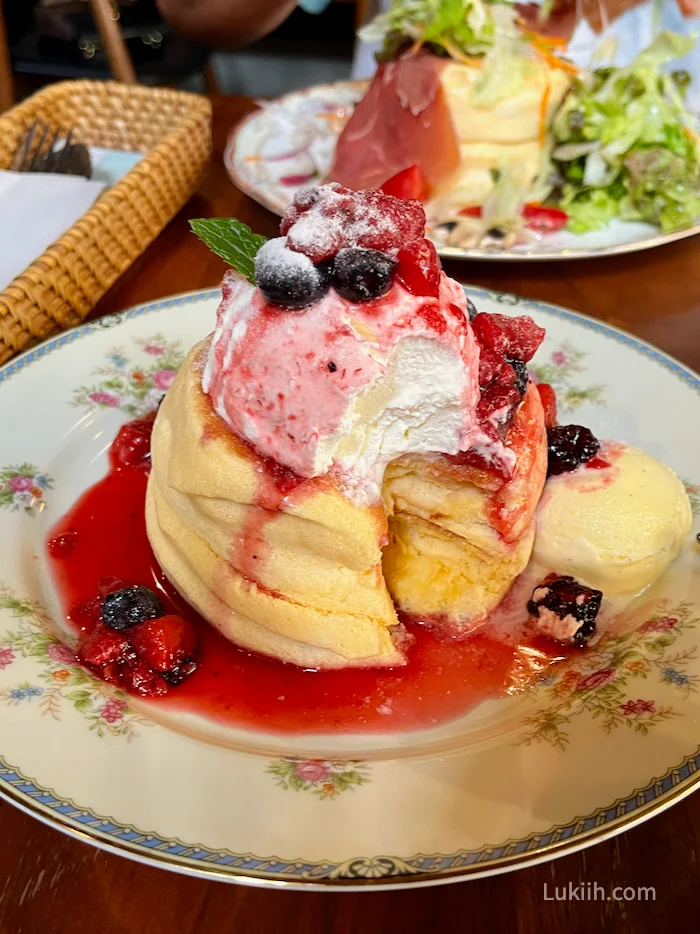
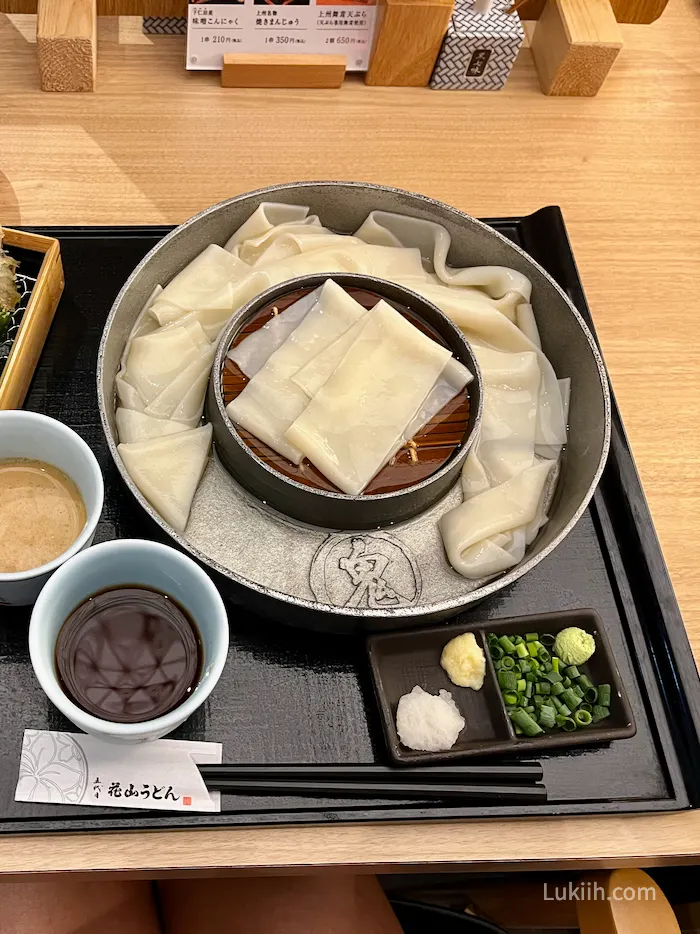
My Japan trip planner has an in-depth guide for English speakers on how to find authentic restaurants using a local app.
What To Wear
- What to wear – Japan has a more conservative culture where you’ll stand out if you show skin. That being said, many tourists, including myself, seem to wear whatever we think it’s appropriate for the weather (i.e., I wore shorts and tanks in the heat).
- How locals dress – They typically dress conservatively. Even in the hot summer days, you’ll rarely see shorts or locals bearing too much skin.
A comprehensive packing list is included in my Japan trip planner.
💡 Miscellaneous Tips
Other practical observations I made during my trip:
- Don’t wear shoes indoors – Many accommodations in Japan are designed so that you’ll be encouraged to leave your outdoor shoes at the door. This is a deep-rooted Japanese tradition and helps keep the space clean, which is important if you’re sitting on the floor or tatami mats, a type of traditional flooring.
- Stay in a ryokan for at least a night – Ryokans are traditional Japanese inns that provide a unique atmosphere experience and are typically more expensive than a mid-range hotel. A ryokan usually serves kaiseki, a multi-course Japanese meal, for breakfast, dinner, or both.
- Expect to carry your own trash – Trash cans are not readily available on streets, but you will find some in train stations and convenience stores. I had to get used to carrying my trash with me sometimes.
- Pedestrians have the right of way – Cars often give the right of way to pedestrians, which confused me as someone who lives in a country where I worry about getting run over if I’m not careful.
- Be quiet in public spaces – Cities in Japan are surprisingly quiet. Silence is a signal that you respect others. You’ll notice that a lot of public spaces, even in crowded train stations, are generally quiet. Make sure to not speak too loudly and to be mindful of your volume.
Japan Trip Planner 2025
Make planning easier with my flexible, research-backed travel planner—shaped by real experience. It has:
- Up-to-date travel info
- A well-curated itinerary
- Practical, firsthand insights & tips
- A simple budget tracker
- A starter packing list
- Fully customizable sections
Built in Notion, this is the tool I personally use to plan every trip. I genuinely love it and creating a Notion account is free.
Lists by Lukiih is a small site I fund myself. Downloading my trip planner is the best way to support me and keep it running—thanks!
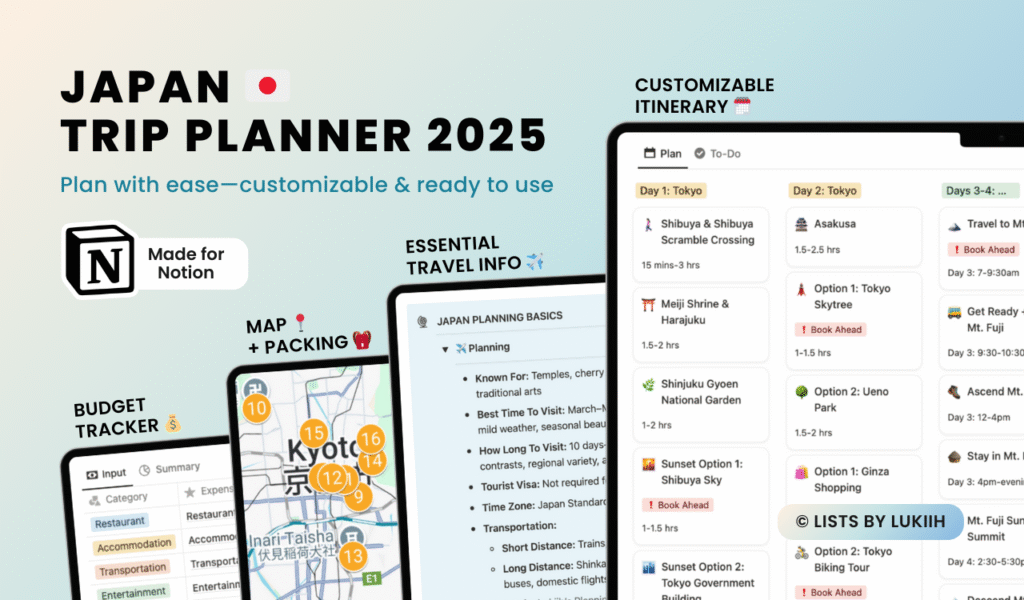
Japan Travel Guides
- 🇯🇵 Planning a Trip to Japan: 12 Practical Things To Know
- ⛩️ 10 Epic Days in Japan: A Unique & Active Itinerary
- 💰 My Japan Trip Cost: Budget Breakdown (2025)
- 🌋 Hiking Mt. Fuji: Honest Review & Tips
- 🚲 Cycling Shimanami Kaido: Honest Review & Tips
- ⛩️ Fushimi Inari Taisha: Honest Review & Tips
- 🙅🏻♀️ Etiquette in Japan: 13 Things Tourists Should Not Do
- ☀️ Visiting Japan in September: Tips & What To Know
- ❄️ Visiting Japan in December: Tips & What To Know
